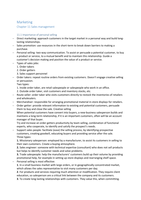Samenvatting
Summary Marketing chapter 11
Perfecte samenvatting voor het behalen van het tentamen, heeft er ook voor gezorgd dat ik mijn propedeuse heb gehaald. Perfect summary to help pass your exam, also helped me obtain my first year certificate (propedeuse).
[Meer zien]





